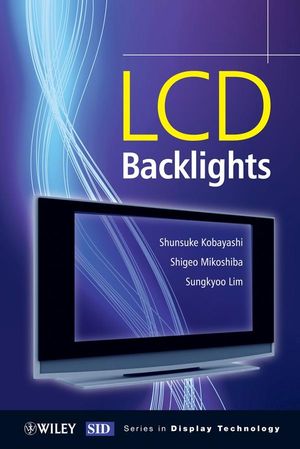LCD BacklightsISBN: 978-0-470-69967-6
Hardcover
296 pages
May 2009
 This is a Print-on-Demand title. It will be printed specifically to fill your order. Please allow an additional 10-15 days delivery time. The book is not returnable.
|
||||||
About the Editors.
List of Contributors.
Preface.
PART ONE BACKLIGHTS BY USE.
1 Technical Trends and Requirements/Specifications for LCD TV Backlights (S. Y. Lee, SAMSUNG Electronics).
1.1 Introduction.
1.2 Structure of LCD TV Backlights.
1.3 Trends in LCD TV Backlights.
1.4 Requirements/Specifications for LCD TV Backlights.
1.5 Conclusions.
References.
2 Improvement of Moving Picture Quality by Means of Backlight Control (T. Yamamoto, Hitachi, Ltd).
2.1 Introduction.
2.2 Blur of Moving Images on LC Displays.
2.3 Methods of Reducing Motion Blur.
2.4 Backlight Blinking.
2.5 Conclusions.
References.
3 Multiple Primary Color Backlights (H. Sugiura, Mitsubishi Electric Corporation).
3.1 Present Status.
3.2 Technological Impacts.
3.3 Operation of Prototype, Six-primary-color Monitor.
3.4 Details of a Six-primary-color Backlight Unit.
3.5 Signal Processing of Transforming from Three Primaries to Six Primaries.
3.6 Color Gamut of the Prototype Monitor.
3.7 Other Techniques for Multiple Primary Color LC-TVs.
3.8 Remaining Issues.
References.
4 Reduction of Backlight Power Consumption of LCD-TVs (T. Shiga, The University of Electro-Communications).
4.1 Introduction.
4.2 Display Method of LCD and Power Reduction.
4.3 Principle of the Adaptive Dimming Technique.
4.4 Adaptive Dimming Control and Power Consumption.
4.5 Other Features of the Adaptive Dimming Technique.
References.
5 Notebook PC/Monitor Backlights (B. H. Hong, Kwangwoon University).
5.1 Introduction.
5.2 Characteristics Required for Backlights.
5.3 Optical Systems for Backlights.
5.4 Light Sources for Backlights.
5.5 Optical Components of Backlights.
References.
6 Backlights for Handheld Data Terminals (S. Aoyama, Omron Corporation).
6.1 Introduction.
6.2 Basic Structure and Principles of LED Backlights.
6.3 Constituents of LED BLUs.
6.4 Various LED Backlight Configurations.
6.5 Conclusions.
References.
PART TWO LIGHT SOURCE DEVICES.
7 CCFL Backlights (K. Yamaguchi, Panasonic Photo & Lighting).
7.1 Introduction.
7.2 Structure and Operating Principle of CCFLs.
7.3 Basic Characteristics of CCFLs.
7.4 Future Trends in CCFLs.
7.5 Conclusions.
8 CCFL Inverters (T. Uematsu, TDK).
8.1 Introduction.
8.2 Various Drive Schemes of CCFL Inverters.
8.3 Equivalent Circuit of CCFLs.
8.4 Inverter Circuits.
8.5 Driving of CCFLs with Inverters.
8.6 Lamp Current Balancers for Driving Multiple Lamps.
8.7 Conclusions.
References.
9 HCFL Backlights (A. A. S. Sluyterman, Philips Lighting).
9.1 HCFL Light Source as a Member of the Fluorescent Lamp Family.
9.2 Introduction of the Hot Cathode in Fluorescent Lamps.
9.3 Driving the HCFL.
9.4 Cathode Life Properties of HCFL.
9.5 Lumen Maintenance and Color Point Shift during Life.
9.6 Designing a Backlight with HCFL.
9.7 The Scanning Feature, Cost-effectively Enabled by HCFL.
9.8 The Dimming Feature.
9.9 Conclusions.
References.
10 EEFL Backlights (J.-H. Ko, Hallym University).
10.1 Introduction.
10.2 Basic Characteristics of EEFLs.
10.3 Advantages and Disadvantages of EEFL Backlights.
10.4 Technological Trends of EEFL Backlights.
10.5 Development Targets.
10.6 Conclusions.
References.
11 FFL Backlights (G. Kim, GLD Co., Ltd. and Mirae Corporation, and S. Lim, Dankook University).
11.1 Introduction.
11.2 The History of FFL Development.
11.3 Characteristics of FFLs.
11.4 Features of the FFL.
References.
12 Magnetically Coupled Electrodeless Lamps (F. Okamoto, Matsushita Electric Works).
12.1 Introduction.
12.2 The Operating Principle of Electrodeless Lamps.
12.3 Environmental Protection.
12.4 Features of Electrodeless Lamps.
12.5 Commercial Products with Electrodeless Lamps.
12.6 Trends in Research and Development.
12.7 Application to LCD Backlights.
12.8 Conclusions.
References.
13 Mercury-free Fluorescent Lamp Backlights (T. Shiga, The University of Electro-Communications).
13.1 Introduction.
13.2 Basic Characteristics of Mercury Discharge.
13.3 Basic Characteristics of Xenon Discharge.
13.4 Mercury-free Xe Discharge Fluorescent Lamps.
13.5 Mercury-free Xe Flat Discharge Lamp.
13.6 Conclusions.
References.
14 LED Backlights (M. Zeiler and J. Hüttner, OSRAM Opto Semiconductors GmbH).
14.1 Introduction.
14.2 LED Device Principle.
14.3 LED Backlight Solutions for Different LCD Sizes.
14.4 Conclusions.
References.
15 Technological Trends of LED Backlight Units (Y. Kondo, NEC LCD Technologies).
15.1 Introduction.
15.2 Structure of LED Backlight Units.
15.3 Design of LED Backlight Units.
15.4 Requirements for Backlight Units.
15.5 Technical Trends of LED Backlights.
15.6 Applications of LED Backlights.
15.7 Conclusions.
16 White OLED Backlights (J. Jang, Kyung Hee University).
16.1 Introduction.
16.2 White OLED with a Single-layer Emission.
16.3 White OLED with Multi-layer Emission.
16.4 WOLED with Color Conversion.
16.5 Stacked WOLED Devices.
16.6 Applications of WOLEDs.
16.7 Research and Development Status.
References.
17 Inorganic EL Backlights (S. Okamoto, NHK Science & Technical Research Laboratories).
17.1 Introduction.
17.2 Classification of Inorganic EL Devices.
17.3 Device Structures and Characteristics.
17.4 High-luminance Inorganic EL Devices.
17.5 Practical Examples of Backlight Use.
References.
18 Field Emission Backlights (M. Ushirozawa, NHK Science & Technical Research Laboratories).
18.1 Introduction.
18.2 Field Electron Emitter.
18.3 Lamp Container and Vacuum Seal.
18.4 Cathodoluminescent Phosphor.
18.5 Issues Relating to Practical Field Emission Backlights.
References.
PART THREE OPTICAL COMPONENTS.
19 Light-guide Plates (Y. Ishiwatari, Asahi Kasei Chemicals).
19.1 Introduction.
19.2 Market Demands for PMMA.
19.3 Characteristics of PMMA.
19.4 Manufacturing Method for PMMA Plates.
19.5 Applications to LCD Backlight Units.
19.6 Characteristics Required for Materials of Light-guide Plates.
19.7 Materials for Extrusion Molding and Injection Molding.
19.8 Conclusions.
References.
20 Optical Diffuser Plates (Y. Ishiwatari, Asahi Kasei Chemicals).
20.1 Introduction.
20.2 PMMA Light Diffuser Plates.
20.3 MS and PS Light Diffuser Plates.
20.4 Trends in Light Diffuser Plates.
20.5 LED Light Sources and Diffusing Plates.
21 Lens Films and Reflective Polarization Films (F. Hanzawa, Sumitomo 3M).
21.1 Introduction.
21.2 Fundamentals of Reflection and Refraction.
21.3 Lens Films (Upward Direction).
21.4 Lens Films (Downward Direction).
21.5 Reflective Polarization Films.
21.6 Resin-type Specular Reflection Films.
21.7 Applications of Films.
21.8 Standards.
References.
Index.



